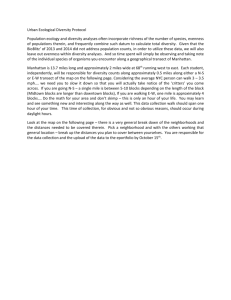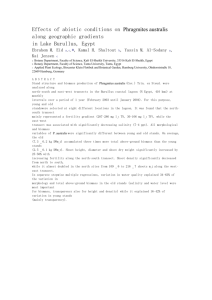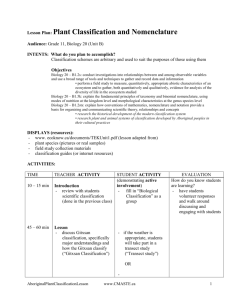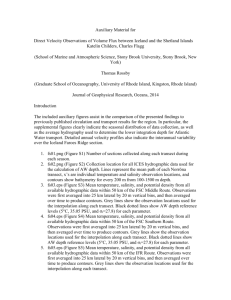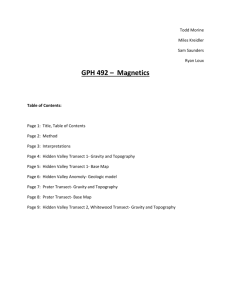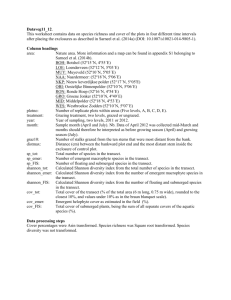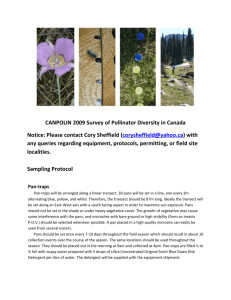Monitoring Colorado`s Birds: - Rocky Mountain Bird Observatory
advertisement
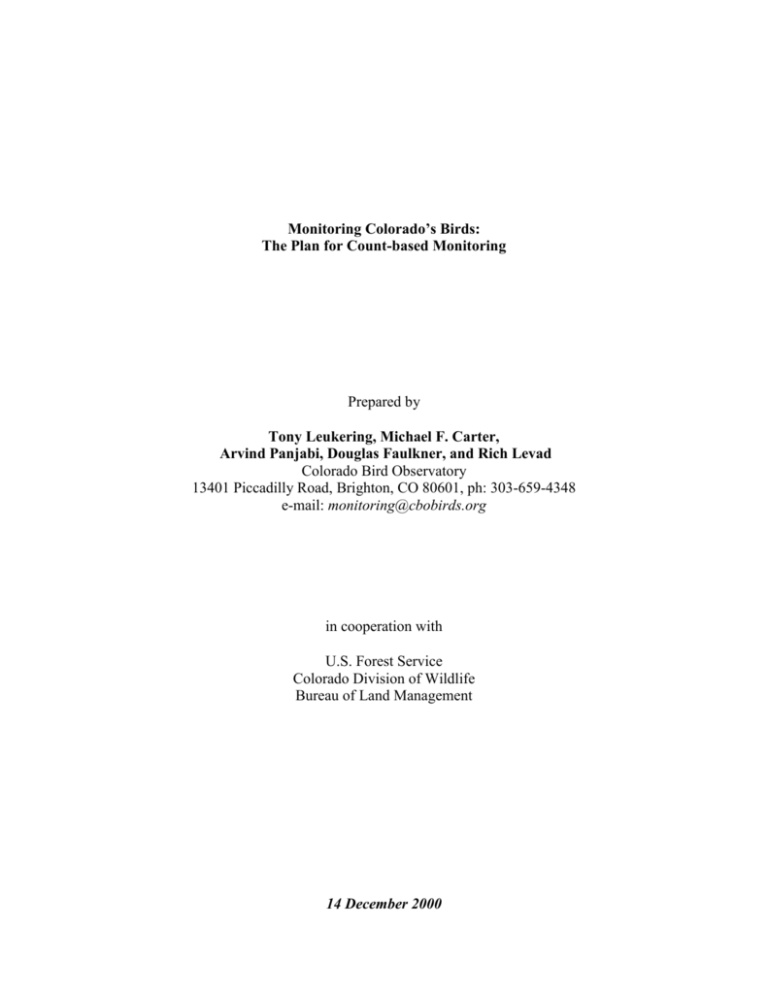
Monitoring Colorado’s Birds: The Plan for Count-based Monitoring Prepared by Tony Leukering, Michael F. Carter, Arvind Panjabi, Douglas Faulkner, and Rich Levad Colorado Bird Observatory 13401 Piccadilly Road, Brighton, CO 80601, ph: 303-659-4348 e-mail: monitoring@cbobirds.org in cooperation with U.S. Forest Service Colorado Division of Wildlife Bureau of Land Management 14 December 2000 Introduction Population monitoring is the backbone of avian conservation. Without current monitoring data, conservation efforts are likely to be misguided and inefficient. Monitoring is required under federal and state legislative and resource management agency mandates as well as a host of long-range plans, Forest plans, ecoregional plans, preserve management plans, etc. (Sauer 1993, Manley et al. 1993, Colorado Division of Wildlife 1994). From a global biodiversity perspective, Colorado hosts many species of birds at or near their greatest regional abundances (Appendix A) and therefore has a high, long-term responsibility for conserving these species (sensu Rosenberg and Wells 2000). The effective conservation and management of Colorado’s birds depends on adequate monitoring information, which to a large extent, does not exist. To date, resource managers have relied on data derived from the Breeding Bird Survey (BBS), currently the best and most extensive bird-monitoring program, to monitor bird populations (Robbins et al. 1989, Sauer 1993). The BBS uses volunteers to conduct roadside surveys of birds across North America and produces indices of population abundance at the continental scale for many common bird species (see Robbins et al. 1986). Unfortunately, the design and implementation of the BBS is such that results generated from these efforts are often inconclusive due to the difficulty associated with interpreting index counts (Sauer 2000), as well as numerous confounding variables (Robbins et al. 1986, Bohning-Gaese et al. 1993, Sauer et al. 1994, James et al. 1996, Thomas 1996, Rosenstock et al. in prep.). In addition, many species and habitats are inadequately sampled by the BBS (Robbins et al. 1993, Sauer 1993) and BBS data do not reliably predict population trends at low geographic scales (Sauer 2000). Finally, BBS data have limited use for determining responses of bird communities to environmental change and/or management action, and in identifying causes of population change (Sauer and Cooper 2000), in part because habitat data are not recorded during BBS counts. For these reasons, BBS data are generally insufficient to guide local or regional management decisions. Several authors have suggested the implementation of regional habitat-based bird monitoring programs to complement data generated by BBS (Butcher 1992, Butcher et al. 1993, Sauer 2000, Sauer and Cooper 2000). In cooperation with the agencies charged with protecting and managing Colorado’s birds, Colorado Bird Observatory (CBO) has proposed and implemented a bird monitoring program for the state in which every agency/organization has the opportunity to contribute and benefit (Table 1). This plan depends on each agency assuming responsibility for the dominant habitats on the lands they manage. This program is currently supported by Colorado Division of Wildlife, U.S. Forest Service, Bureau of Land Management, and National Park Service. This project is entitled Monitoring Colorado’s Birds (MCB). Monitoring Colorado’s Birds is designed to provide population trend or status data on all regularly-occurring breeding species in the state. A total of 280 species of birds has bred in Colorado, 256 annually. The first phase of MCB is to ensure that count-based data are obtained for all species which can be monitored effectively through a habitat-based approach, and that species-specific tracking or census programs are employed for those species requiring more specialized techniques. The second phase should include demographic studies to determine the possible reasons for known declines and for the purposes of developing management information. Herein we develop a plan for Phase I, the count-based monitoring of all of Colorado’s regularly- breeding bird species. This plan was developed using information drawn from BBS data, Colorado Breeding Bird Atlas data, and Partner’s In Flight (PIF) priority scores (Appendix A). Monitoring Colorado’s Birds, page 3 MCB was first drafted as a state-based plan that draws funding only from agencies within Colorado, and focuses solely on habitats within the state. However, a biologically-based plan would provide more meaningful and complete monitoring data on bird populations. Therefore, it is our goal to expand this program in the near future to the level of Bird Conservation Region (BCR). BCRs are more ecologically-meaningful management units for birds because they encompass distinct ecoregions in North America that host similar bird communities (NABCI Committee 2000). Colorado is primarily comprised of two distinctly contrasting BCRs: the Shortgrass Prairie (BCR#18) and the Southern Rockies/Colorado Plateau (BCR#16), each of which extend into neighboring states. A BCR-level plan would require that all states occupying significant portions of BCRs contribute proportionately to fund monitoring efforts in those BCRs. Such a plan would be more cost-effective because it would eliminate duplicate efforts by states to obtain independent data sets from habitats they share with other states, while still providing meaningful data on bird populations that could be used at the state level. Partners In Flight has adopted the BCR as the focus unit for ranking conservation priorities among bird species, and the North American Bird Conservation Initiative (NABCI) has stressed the need for regionally-based approaches to bird conservation involving cooperative partnerships within BCRs (NABCI Committee 2000). Background Although analyses of BBS data have indicated population declines in some bird species (Robbins et al. 1986), we do not believe that there are wholesale declines in birds as reported by some media, individuals, initiatives, or environmental groups. However, population trend data for many western bird species are lacking (see Appendix A). Using criteria established by Carter et al. (2000), currently at least 78% of Colorado’s regularly-breeding species in BCR 16, and 76% of its’ regularly breeding species in BCR 18 are not adequately monitored by the BBS (Appendix A). Of the species that are well monitored by the BBS in these BCRs, there are some species whose populations are declining, some that are increasing, and some that are stable (Appendix A). Consider, however, that if proportions of increasing, decreasing, and stable species are roughly the same in the list of unmonitored species as they are in the list of monitored species, then it is likely that a considerable number of population declines still remain undetected. Furthermore, because declines are harder to detect than increases (variance increases as populations decline), the proportion of declining species in the unmonitored list is probably even higher. Statistical Targets and Assumptions Monitoring should be efficient, low-level, and permanent, and we have designed this program with these points in mind. To do monitoring correctly, one needs a target -- a threshold of time span and population change that balances statistical rigor with cost-effectiveness. It is desirable to detect a fairly small population change (particularly, a negative one) in a fairly short amount of time. However, the sample sizes required would probably outstrip all funding available for such an undertaking. Therefore, as our target we have selected a minimum rate of Monitoring Colorado’s Birds, page 4 population change of -3.0% per year and a maximum time period of 30 years in which to detect population changes (see Butcher 1992, Robbins et al. 1993 for similar trend detection targets). We used the formula: cumulative change = ([(annual change/100)+1] n-1 -1)(100) to calculate total population loss over a 30-year period with an annual decline of 3.0%. This equates to a 58.7% loss of a population in 30 years which is probably not large enough to trigger listing under the Endangered Species Act. It is, however, advance warning enough to trigger action. Along with this target are assumptions. What levels of statistical rigor (i.e. power and significance) would we like to reach? We selected a statistical probability of p=0.10 (Askins et al. 1990, Butcher 1992) to indicate a significant population change. A statistical probability of p=0.10 gives moderate protection against Type I error (finding trends that are false). We gave MCB only such moderate protection, because it is often more useful and practical for wildlife managers to determine the direction and magnitude of a trend than establish its significance at a very high level (i.e. traditionally, p=0.05). Similarly, we set power at 0.8 (Butcher 1992, Downes et al. 2000), which gives moderate protection against Type II error (failing to find trends that are real). Considering cost and the need to have a sufficient number of well-dispersed sampling units, we initially designed this program with 30 samples (i.e. transects) per habitat. Using pilot data from 1998, we tested this number of samples and confirmed that 30 would be sufficient to meet our target and assumptions. With these assumptions, we used the computer program MONITOR (Patuxent Wildlife Research Center 2000) to model the efficiency of 30 pilot transects run in each of three habitats in 1998 (Leukering and Carter 1999). Specifically, we used MONITOR to determine the threshold for the coefficient of variation (CV; Standard Deviation/Mean) associated with pointtransect data that will generate useful monitoring information. A CV reflects the overall variability of data scaled against the mean; that is, species with large abundances but high variability have CVs similar to those of species with low abundance and low variability. CVs are a function of factors inherent to a species (its abundance and variability in nature) and statistical considerations such as sample size and method of sampling. MONITOR indicates that for species with associated CVs of less than 1.00, we will be able to detect 3.0%/year declines within 30 years of monitoring, with a statistical significance of p=0.1 and power of 0.8. For species with CVs of less than 0.50, MONITOR indicates that we will be able to detect declines of 3.0%/year within 12 years. Methods MCB employs a variety of survey techniques (e.g., point transects, line transects, and colony counts) to obtain trend and status data on Colorado’s birds. Each technique is thoroughly described by Leukering and Levad (2000) and summarized in Appendix B. An underlying tenet of MCB is to allocate more effort to those species for which Colorado is an important breeding area, and relatively little effort to species which are peripheral to the area. While most species can be monitored through use of a single technique, the ecologies of some species are such that those species are not adequately surveyed through randomized sampling efforts. Therefore, not all species will be monitored by the same technique, nor will every species be monitored. Game Monitoring Colorado’s Birds, page 5 species and federally-listed Threatened or Endangered (T&E) species will not receive specific attention under MCB, as monitoring programs already exist for these species under other mandates. We believe monitoring efforts under MCB should focus on those species currently not monitored under any program. However, data generated by MCB on these species will be available and could be used to supplement other management information for these species. Although we use the term “monitoring” loosely throughout most of this plan, in the strictest sense, “monitoring” is possible only for those species for which we can obtain a sufficient number of samples (i.e., those species with CVs<1.00) to meet high levels of statistical rigor when testing for population change. For some species that occur in low relative abundance across the landscape, “monitoring” will not be possible without greatly increasing the amount of funds and effort devoted toward those species. Instead, we intend to “track” populations of lowabundance or localized species, with the implication being that any trends detected for these species will have low statistical power. For transect-based data, bird species with associated CVs of less than 1.00 (most will be under 0.50) will be “monitored”, whereas those with CVs greater than 1.00 will be “tracked”. For data obtained through species-specific techniques, “monitoring” will be possible for those species for which we are able to locate and survey all known breeding locations in a given year (e.g. Eared Grebe, Great Blue Heron, and Franklin’s Gull). For rare or local species whose breeding locations are not known with complete certainty, we will “track” populations using counts at known breeding locations (e.g. Green Heron, Scott’s Oriole, Bell’s Vireo). MCB relies primarily on transect-based techniques, through which we expect to monitor approximately 42% of Colorado’s breeding bird species and track an additional 23% (Table 2). Through the use of species-specific techniques, we expect to monitor 6% and track an additional 14% of Colorado’s breeding birds (Table 2). The remaining 15% of species are T&E or Game species not covered under MCB. Standard distance-sampling techniques (Buckland et al. 1993) are used during all transect surveys, and density estimates of bird species are derived using program DISTANCE (Thomas et al. 1998). We have become painfully aware of the many problems associated with sampling bird populations and believe that distance-sampling techniques may be useful in sorting out problems of detectability that could result from a myriad factors, most importantly changes to the habitat over the term of this program. We do not intend to use these techniques to develop densities as an end product, but rather as a tool to derive an index that is not confounded by detectability issues. In the event that distance sampling techniques do not prove to be useful, we will analyze our data using more traditional techniques (e.g., via fixed radii). All transects (except nocturnal transects) are located at randomly selected sites and are not biased toward or against roads, as starting points and transect bearing are determined randomly. All technicians are highly-skilled field ornithologists and each goes through a training session at the beginning of the season to ensure that the field protocol is fully understood and that distanceestimation skills are reasonably similar (within 10% of true value) among crew members. Products Annual summaries of results and periodic trend analyses will be provided to all participating agencies via paper reports, publications, and the World Wide Web. Monitoring Colorado’s Birds, page 6 Funding/Cost To date, MCB has been funded primarily by the Great Outdoors Colorado Trust Fund through Colorado Division of Wildlife. Other partners have provided substantial cash and inkind contributions. We estimate that count-based data for each habitat will cost approximately $10,338/year (Table 3). This figure includes only the costs to obtain transect-based data from each habitat and does not specifically allocate funds for species-specific monitoring techniques. However, when multiple habitats are included in the budget, the synergistic effects of per-habitat funding (i.e., overlap in data management, analysis, report writing, etc.) should provide sufficient funds to cover the cost of most species-specific monitoring techniques. In Colorado, the program has been funded to address 16 habitats, which provides sufficient funds to address most species with the appropriate technique. Literature Cited Askins, R.A., J.F. Lynch, and R. Greenburg. 1990. Population declines in migratory birds in eastern North America. Current Ornithology 7:1-57. Bohning-Gaese, K., M.L. Taper, and J.H. Brown. 1993. Are declines in insectivorous songbirds due to causes on the breeding range? Conservation Biology 7:76-86. Buckland, S.T., D.R. Anderson, K.P. Burnham, and J.L. Laake. 1993. Distance Sampling: Estimating Abundance of Biological Populations. Chapman and Hall, London, reprinted 1999 by RUWPA, University of St. Andrews, Scotland. 446pp. Butcher, G.S. (ed.). 1992. Needs Assessment: Monitoring Neotropical Migratory Birds. Partners In Flight, Ithaca, NY. 58 pp. Butcher, G.S., B. Peterjohn, and C.J. Ralph. 1993. Overview of national bird population monitoring programs and databases. In Finch, D.M. and P.W. Stangel (eds.), Status and Management of Neotropical Migratory Birds; 1992 Sept. 21-25; Estes Park, CO. Gen. Tech. Rep. RM-229. Fort Collins, CO. USDA Forest Service, Rocky Mountain Forest and Range Experiment Station. 422 pp. Carter, M.F., W.C. Hunter, D.N. Pashley, and K.V. Rosenberg. 2000. Setting conservation priorities for landbirds in the United States: The Partners In Flight approach. Auk 117:541548. Colorado Division of Wildlife. 1994. Long Range Plan (Revised Draft). Colorado Department of Natural Resources, Division of Wildlife, Denver. 33 pp. Downes, C.M., E.H. Dunn, and C.M. Francis. 2000. Canadian Landbird Monitoring Strategy: Monitoring needs and priorities into the new millennium. Partners In Flight-Canada, Ottawa. 64 pp. James, F.C., C.E. McCullough, and D.A. Weidenfeld. 1996. New approaches to the analysis of population trends in landbirds. Ecology 77:13-27. Leukering, T. and M.F. Carter. 1999. Colorado Birds Monitored by 2001: Results of pointtransects in three Colorado habitats with an appendix of results of special species monitoring. Colorado Bird Observatory, unpublished report. 34 pp. Leukering, T. and R. Levad. 2000. Monitoring Colorado’s Birds: Protocols. Colorado Bird Observatory unpublished document. 16 pp. Monitoring Colorado’s Birds, page 7 Manley, P.N., W.M. Block, F.R. Thompson, G.S. Butcher, C. Paige, L.H. Suring, D.S. Winn, D. Roth, C.J. Ralph, E. Morris, C.H. Flather, and K. Byford. 1993. Guidelines for Monitoring Populations of Neotropical Migratory Birds on National Forest System Lands. USDA Forest Service, Washington. 35 pp. NABCI Committee. 2000. North American Bird Conservation Initiative in the United States: A vision of American bird conservation. USFWS, Div. of North American Waterfowl and Wetlands, Arlington, VA. Patuxent Wildlife Research Center. 2000. Program MONITOR. http://www.mp1pwrc.usgs.gov/powcase/Manual.htm version11.2000. Robbins, C.S., D. Bystrak, and P.H. Geissler. 1986. The Breeding Bird Survey: It’s first fifteeen years, 1965-1979. U.S. Fish and Wildlife Resource Publication 157. 196 pp. Robbins, C.S., J.R. Sauer, R.S. Greenburg, and S. Droege. 1989. Population declines in North American birds that migrate to the neotropics. Proc. Natl. Acad. Sci., USA 86:7658-7662. Robbins, C.S., J.R. Sauer, and B.G. Peterjohn. 1993. Population trends and management opportunities for Neotropical migrants. In Finch, D.M. and P.W. Stangel (eds.) Status and Management of Neotropical Migratory Birds; 1992 Sept. 21-25; Estes Park, CO. Gen. Tech. Rep. RM-229. Fort Collins, CO. USDA Forest Service, Rocky Mountain Forest and Range Experiment Station. 422 pp. Rosenberg, K.V. and J.V. Wells. 2000. Global perspectives on Neotropical migratory bird conservation in the Northeast: Long-term responsibility versus immediate concern. In R. Bonney et al. (eds.), Strategies for Bird Conservation: The Partners in Flight Planning Process. Proceedings of the 3rd Partners In Flight Workshop; 1995 Oct. 1-5, Cape May, NJ. USDA Forest Service, Rocky Mountain Research Station, 281 pp. Rosenstock, S.S., D.R. Anderson, K.M. Geisen, T. Leukering, and M.F. Carter. In prep. Estimating landbird abundance: current practices and an alternative. Sauer, J.R. 1993. Monitoring Goals and Programs of the U.S. Fish and Wildlife Service. In Finch, D.M. and P.W. Stangel (eds.) Status and Management of Neotropical Migratory Birds; 1992 Sept. 21-25; Estes Park, CO. Gen. Tech. Rep. RM-229. Fort Collins, CO. USDA Forest Service, Rocky Mountain Forest and Range Experiment Station. 422 pp. Sauer, J.R., B.G. Peterjohn, and W.A. Link. 1994. Observer differences in the North American Breeding Bird Survey. Auk 111:50-62. Sauer, J.R. 2000. Combining information from monitoring programs: complications associated with indices and geographic scale. In R. Bonney et al. (eds.), Strategies for Bird Conservation: The Partners in Flight Planning Process. Proceedings of the 3rd Partners In Flight Workshop; 1995 Oct. 1-5, Cape May, NJ. USDA Forest Service, Rocky Mountain Research Station. 281 pp. Sauer, J.R. and R. Cooper. 2000. Population and habitat assessment: Monitoring bird populations over large areas. In R. Bonney et al. (eds.), Strategies for Bird Conservation: The Partners in Flight Planning Process. Proceedings of the 3rd Partners in Flight Workshop; 1995 Oct. 1-5, Cape May, NJ. USDA Forest Service, Rocky Mountain Research Station. 281 pp. Stahlecker, D.W. 1997. Using tape playback of the staccato song to document Boreal Owl (Aegolius funereus) reproduction. In Duncan, J.R., D.H. Johnson, and T.H. Nicholls (eds.), Biology and Conservation of Owls of the Northern Hemisphere: 2d International Symposium; 1997 February 5-9; Winnipeg, MB. Gen. Tech. Rep NC-190. St. Paul MN: U.S.D.A. Forest Service, North Central Research Station. 635 p. Monitoring Colorado’s Birds, page 8 Thomas, L. 1996. Monitoring long-term population change: why are there so many analysis methods? Ecology 77:49-58. Thomas, L., J.L. Laake, J.F. Derry, S.T. Buckland, D.L. Borchers, D.R. Anderson, K.P. Burnham, S. Strindberg, S.L. Hedley, M.L. Burt, F.F.C. Marques, J.H. Pollard, and R.M. Fewster. 1998. Distance 3.5. Research Unit for Wildlife Population Assessment, University of St. Andrews, UK. Monitoring Colorado’s Birds, page 9 Table 1. Designations by habitat of responsible agencies with numbers of species expected to be monitored or tracked in each habitat1. # species monitored3 # species tracked3 11 4 2 6 0 8 6 1 9 9 8 4 0 4 8 1 3 1 1 5 2 2 6 22 15 5 27 12 Dispersed, non-uniform, and/or anthropogenic habitats6 CO Division of Wildlife 5 CO Division of Wildlife 6 CO Division of Wildlife 5 9 10 1 123 95 2 Habitat Agency Pinyon-Juniper Sage Shrubland Semidesert Shrubland Grassland Lodgepole Pine Montane Shrubland Ponderosa Pine Alpine Tundra Spruce-Fir Aspen Mixed Conifer High-elevation Riparian Low-elevation Riparian Wetlands Cliff/Rock Rural/Agriculture Shore/Bank TOTAL 1 Uniform-block habitats4 Bureau of Land Management Bureau of Land Management Bureau of Land Management CO Division of Wildlife CO Division of Wildlife CO Division of Wildlife CO Division of Wildlife National Park Service U.S. Forest Service U.S. Forest Service U.S. Forest Service Non-uniform-block habitats5 CO Division of Wildlife CO Division of Wildlife CO Division of Wildlife Species are allocated to the habitat in which they achieve maximum density in Colorado. However, most species occur across a range of habitats. Therefore, for each habitat, we will obtain monitoring data on numerous species other than those specifically allocated to that habitat. 2 Though some agencies are associated herein with certain habitats that host few species, all agencies will benefit from Monitoring Colorado’s Birds due to the availability of monitoring data to all. 3 See Methods for distinction between “monitored” vs. “tracked”. 4 Uniform-block habitats are those that we believe will be well sampled with random allocation of point transects. 5 Non-uniform-block habitats are those that will require extra effort or somewhat different counting techniques due to the widespread, but localized or narrow aspects of those habitats. 6 These habitats are not vegetation-based, are found across large elevational gradients, and host species specific to the habitat, but not necessarily the associated vegetation type. We do not anticipate allocating transects to these habitats; funding for these will be dispersed among other habitats, devoted to species-specific techniques, and/or used to interpret BBS data. Monitoring Colorado’s Birds, page 10 Table 2. Number and percent of regularly-breeding bird species that MCB will monitor and track per survey method. Method Transect-based techniques Point transect Line transect Nocturnal transect Total, transect-based techniques Species-specific techniques Statewide survey Colony count Expert survey Total, special techniques Not monitored under MCB Threatened & Endangered Game species Total, political designations TOTAL # species # species monitored (%) tracked (%) Total Percent of total (n=256) 77 26 4 107 (42%) 37 17 6 60 (23%) 114 43 10 167 (65%) 44.5 16.8 3.9 65.2 1 15 0 16 (6%) 16 3 16 35 (14%) 17 18 16 51 (20%) 6.6 7.0 6.3 19.9 0 0 0 5 33 38 5 33 38 2.0 12.9 14.9 123 133 256 100.0 Monitoring Colorado’s Birds, page 11 Table 3. Proposed budget to perform monitoring in one habitat under MCB. Item Cost Personnel 45 days1 (2.25 mos.) of technician time ($1700/mo.) $3,825 Organization/analysis/report (senior staff for 3 wks @ $2,800/mo.) Taxes and benefits (12.46%) $2,100 $738 Personnel subtotal $6,663 Logistics Mileage (3,300 mi x 0.28/mi.) $924 Lodging (18 nights @ $40/night) $720 Field food (45 days x $15/day) $675 Logistics subtotal $2,319 Indirect/overhead (15.10%) $1,356 TOTAL (per habitat) $10,338 Field personnel conduct 1 transect/day in the morning, scout the next day’s transect in the afternoon, and whenever possible, conduct species-specific surveys in the afternoon. Staff time includes pre-season training and post-season data entry. 1 Monitoring Colorado’s Birds, page 12 Appendix A. Designated habitat, Partner’s In Flight priority scores for BCRs 16 & 18, suggested methods for and expected results of monitoring for each of Colorado’s breeding bird species. Scores provided are: AI=area importance 1, PT=population trend2, PTDQ=population trend data quality2 (Carter et al. 2000). %POP is an index of a species’ population contained within that BCR (Rosenberg and Wells 2000). BCR 16 BCR 18 Species Habitat AI PT PTDQ %POP AI PT PTDQ %POP Technique Result Pied-billed Grebe Wetlands 2 3 D3 1.13 2 3 E 0.29 Colony count Tracked Eared Grebe Wetlands 3 3 D4 3.19 2 3 D4 0.32 Colony count Monitored Western Grebe Wetlands 2 3 F 0.00 3 3 F 0.00 Colony count Monitored Clark's Grebe Wetlands 2 3 F 0.00 3 3 F 0.00 Colony count Monitored American White Pelican Shore/Bank 3 3 D4 0.59 3 3 D1 3.35 Colony count Monitored Double-crested Cormorant Low-elevation Riparian 2 3 D4 0.21 2 3 D1 0.63 Colony count Monitored American Bittern Wetlands 2 3 D4 0.40 2 3 F 0.09 Line transect Tracked Least Bittern Wetlands 1 3 F 0.00 2 3 F 0.00 Expert survey Tracked Great Blue Heron Low-elevation Riparian 3 3 D3 1.12 2 1 B1 1.08 Colony count Monitored Great Egret Low-elevation Riparian 1 3 F 0.00 1 3 F 0.02 Colony count Monitored Snowy Egret Wetlands 2 3 F 0.33 2 3 F 0.24 Colony count Monitored Little Blue Heron Low-elevation Riparian 1 3 F 0.00 Expert survey Tracked Cattle Egret Wetlands 2 3 F 0.00 1 3 D4 0.09 Colony count Monitored Green Heron Low-elevation Riparian 2 3 F 0.00 2 3 F 0.07 Expert survey Tracked Black-crowned Night-Heron Low-elevation Riparian 2 3 D1 1.39 3 2 C1 8.23 Colony count Monitored Yellow-crowned Night-Heron Low-elevation Riparian 1 3 F 0.00 Expert survey Tracked White-faced Ibis Wetlands 4 3 F 0.87 2 3 F 0.66 Colony count Monitored Turkey Vulture Cliff/Rock 3 2 C2 1.65 2 1 A1 1.94 Point transect Tracked Canada Goose Wetlands 3 2 C3 1.46 2 2 C1 0.17 N/A Tracked Wood Duck Low-elevation Riparian 2 3 F 0.00 2 3 F 0.26 N/A Tracked Gadwall Wetlands 3 3 D3 2.95 2 3 D4 0.19 N/A Tracked American Wigeon Wetlands 2 3 D3 0.39 2 3 F 0.12 N/A Tracked Mallard Wetlands 2 2 C2 1.38 3 2 A2 1.98 N/A Tracked Blue-winged Teal Wetlands 2 3 D4 0.13 2 2 B2 1.28 N/A Tracked Cinnamon Teal Wetlands 3 3 D3 5.77 2 2 C1 1.49 N/A Tracked Northern Shoveler Wetlands 2 3 D1 0.33 2 3 D4 0.78 N/A Tracked Northern Pintail Wetlands 2 3 D4 0.44 2 5 B1 0.47 N/A Tracked Green-winged Teal Wetlands 3 4 C3 1.73 2 3 D4 0.92 N/A Tracked Monitoring Colorado’s Birds, page 13 Species Canvasback Redhead Ring-necked Duck Lesser Scaup Harlequin Duck Bufflehead Barrow's Goldeneye Hooded Merganser Common Merganser Ruddy Duck Osprey Mississippi Kite Bald Eagle Northern Harrier Sharp-shinned Hawk Cooper's Hawk Northern Goshawk Broad-winged Hawk Swainson's Hawk Red-tailed Hawk Ferruginous Hawk Golden Eagle American Kestrel Peregrine Falcon Prairie Falcon Chukar Ring-necked Pheasant Ruffed Grouse Gunnison Sage-Grouse Greater Sage-Grouse Blue Grouse Habitat Wetlands Wetlands Wetlands Wetlands High-elevation Riparian High-elevation Riparian High-elevation Riparian Low-elevation Riparian High-elevation Riparian Wetlands High-elevation Riparian Low-elevation Riparian Low-elevation Riparian Wetlands Spruce-Fir Aspen Mixed Conifer Low-elevation Riparian Grassland Low-elevation Riparian Grassland Cliff/Rock Low-elevation Riparian Cliff/Rock Cliff/Rock Semidesert Shrubland Rural/Agricultural Aspen Sage Shrubland Sage Shrubland Mixed Conifer AI 2 2 4 2 1 2 2 1 4 2 2 2 2 3 5 4 5 PT 3 3 3 3 BCR 16 PTDQ F D1 D1 D1 3 3 3 3 3 3 3 3 3 3 2 3 F F F D1 D1 F F F D4 D4 C3 D3 0.01 0.00 0.00 3.53 2.28 0.25 0.00 0.08 1.52 5.73 5.48 3.96 2 3 2 5 4 4 4 2 2 3 1 3 4 4 3 3 3 4 D4 A1 D3 C2 C6 D4 D3 E C3 2.24 2.78 2.19 13.57 4.47 5.83 11.60 3.12 0.72 5 2 3 5 3 3 9 F D3 100.00 1.19 3.73 %POP 0.11 1.50 4.32 0.88 AI 2 2 PT 3 3 BCR 18 PTDQ F E 1 3 F 0.00 1 1 2 1 3 2 4 2 2 3 3 3 3 3 3 4 3 3 F F F F E F C2 F F 0.00 0.02 0.12 0.02 3.96 0.00 4.37 0.18 0.56 1 5 3 5 4 5 2 1 3 3 2 A2 A1 D2 D3 A2 20.94 1.90 21.11 2.94 4.23 5 1 B1 10.17 5 4 C4 10.02 %POP 0.00 0.59 Technique N/A N/A N/A N/A N/A N/A N/A N/A N/A N/A State-wide survey State-wide survey N/A Point transect Point transect Point transect Point transect Expert survey Point transect Point transect Point transect Point transect Point transect Point transect Point transect N/A N/A N/A N/A N/A N/A Result Tracked Tracked Tracked Tracked Tracked Tracked Tracked Tracked Tracked Tracked Tracked Tracked Tracked Tracked Tracked Tracked Tracked Tracked Tracked Tracked Tracked Tracked Tracked Tracked Tracked Tracked Tracked Tracked Tracked Tracked Tracked Monitoring Colorado’s Birds, page 14 Species White-tailed Ptarmigan Greater Prairie-Chicken Lesser Prairie-Chicken Sharp-tailed Grouse Wild Turkey Scaled Quail Gambel's Quail Northern Bobwhite Black Rail Virginia Rail Sora American Coot Sandhill Crane Snowy Plover Piping Plover Killdeer Mountain Plover Black-necked Stilt American Avocet Willet Spotted Sandpiper Upland Sandpiper Long-billed Curlew Marbled Godwit Common Snipe Wilson's Phalarope Franklin's Gull California Gull Forster's Tern Least Tern Black Tern Habitat Alpine Tundra Grassland Grassland Montane Shrubland Ponderosa Pine Grassland Low-elevation Riparian Low-elevation Riparian Wetlands Wetlands Wetlands Wetlands Wetlands Shore/Bank Shore/Bank Shore/Bank Grassland Wetlands Wetlands Wetlands Low-elevation Riparian Grassland Grassland Grassland Wetlands Wetlands Wetlands Shore/Bank Wetlands Shore/Bank Wetlands AI 4 PT 3 BCR 16 PTDQ F %POP 0.00 2 2 2 2 1 3 3 3 3 3 F D1 D4 D1 F 0.00 1.01 1.02 1.45 0.00 3 2 2 2 3 3 3 3 3 3 F D1 D3 D3 F 1.96 0.18 2.36 0.35 0.00 3 4 1 2 2 3 5 3 3 3 3 4 A1 F F D1 F C2 1.74 4.99 0.03 0.82 0.00 1.63 2 3 D3 0.78 3 3 1 4 2 1 3 A1 D3 1.46 3.14 3 D1 10.77 2 AI PT BCR 18 PTDQ 3 5 2 2 3 3 3 3 3 5 D4 F D3 D3 A1 7.58 0.00 0.58 1.76 8.37 3 2 2 2 2 3 D2 2.55 3 3 3 F F E 0.00 0.00 0.82 3 2 4 5 2 3 1 2 2 5 1 2 2 4 3 2 3 3 3 3 3 4 4 9 F A2 D4 D4 D3 F D4 C3 C2 0.00 0.00 4.79 73.60 0.83 4.93 0.03 0.07 1.37 14.08 3 3 D3 D4 0.09 0.74 2 2 2 2 3 3 4 3 D4 F 9 F 0.70 0.75 0.17 0.08 %POP Technique N/A N/A N/A N/A N/A N/A N/A N/A Expert survey Line transect Expert survey N/A State-wide survey N/A N/A Line transect Point transect State-wide survey Line transect State-wide survey Line transect Expert survey Point transect Expert survey Line transect Line transect Colony count Colony count Colony count N/A Colony count Result Tracked Tracked Tracked Tracked Tracked Tracked Tracked Tracked Tracked Tracked Tracked Tracked Tracked Tracked Tracked Monitored Tracked Tracked Tracked Monitored Monitored Tracked Tracked Tracked Tracked Tracked Monitored Monitored Monitored Tracked Monitored Monitoring Colorado’s Birds, page 15 Species Rock Dove Band-tailed Pigeon Eurasian Collared-Dove Mourning Dove Inca Dove Black-billed Cuckoo Yellow-billed Cuckoo Greater Roadrunner Barn Owl Flammulated Owl Eastern Screech-Owl Western Screech-Owl Great Horned Owl Northern Pygmy-Owl Burrowing Owl Spotted Owl Long-eared Owl Short-eared Owl Boreal Owl Northern Saw-whet Owl Common Nighthawk Common Poorwill Black Swift Chimney Swift White-throated Swift Magnificent Hummingbird Black-chinned Hummingbird Broad-tailed Hummingbird Belted Kingfisher Lewis's Woodpecker Red-headed Woodpecker Habitat Rural/Agricultural Ponderosa Pine Rural/Agricultural Rural/Agricultural Rural/Agricultural Low-elevation Riparian Low-elevation Riparian Semidesert Shrubland Rural/Agricultural Ponderosa Pine Low-elevation Riparian Low-elevation Riparian Low-elevation Riparian Mixed Conifer Grassland Ponderosa Pine Low-elevation Riparian Wetlands Spruce-Fir Pinyon-Juniper Grassland Montane Shrubland Cliff/Rock Rural/Agricultural Cliff/Rock Ponderosa Pine Pinyon-Juniper Aspen Shore/Bank Low-elevation Riparian Low-elevation Riparian AI 2 3 PT 2 3 BCR 16 PTDQ C3 D3 3 1 4 3 C4 F 1.96 0.00 2 1 2 4 3 3 3 3 F D1 F F 0.00 0.58 0.00 0.00 %POP 0.88 2.89 3 3 2 2 2 3 2 3 3 3 3 3 3 3 3 3 3 3 3 3 3 5 3 3 F D3 F D3 F F F F F A1 D3 F 7.08 1.45 6.54 2.28 0.00 0.00 0.01 0.00 0.00 5.85 8.32 0.55 5 1 3 5 3 5 1 3 3 2 4 4 3 3 D2 F C3 C6 C3 D4 F 24.05 0.00 13.09 64.59 1.34 27.09 0.01 AI 3 PT 2 BCR 18 PTDQ C2 2 5 1 2 2 2 4 2 3 3 2 2 3 A2 F F B2 C3 F 7.82 0.00 0.00 0.24 2.05 9.32 2 2 4 3 3 3 F F D2 0.00 0.00 4.31 5 3 D2 34.95 2 2 3 3 F F 0.00 0.16 4 2 4 3 C4 D4 7.41 0.71 2 2 3 3 D1 F 0.19 0.38 2 3 F 0.68 2 4 3 4 4 2 C1 C1 B2 0.41 5.96 2.16 %POP 3.64 Technique Point transect N/A State-wide survey Point transect Expert survey State-wide survey State-wide survey Point transect Nocturnal transect Nocturnal transect Expert survey Nocturnal transect Nocturnal transect Expert survey Colony count N/A Nocturnal transect Nocturnal transect Nocturnal transect Nocturnal transect Point transect Nocturnal transect Colony count Line transect Point transect Expert survey Point transect Point transect Line transect Line transect Point transect Result Tracked Tracked Tracked Monitored Tracked Tracked Tracked Tracked Tracked Monitored Tracked Tracked Tracked Monitored Tracked Tracked Monitored Tracked Tracked Tracked Monitored Monitored Tracked Tracked Tracked Tracked Monitored Monitored Monitored Tracked Tracked Monitoring Colorado’s Birds, page 16 Species Acorn Woodpecker Red-bellied Woodpecker Red-naped Sapsucker Williamson's Sapsucker Ladder-backed Woodpecker Downy Woodpecker Hairy Woodpecker Three-toed Woodpecker Northern Flicker Olive-sided Flycatcher Western Wood-Pewee Willow Flycatcher Least Flycatcher Hammond's Flycatcher Dusky Flycatcher Gray Flycatcher Cordilleran Flycatcher Black Phoebe Eastern Phoebe Say's Phoebe Vermilion Flycatcher Ash-throated Flycatcher Great Crested Flycatcher Cassin's Kingbird Western Kingbird Eastern Kingbird Scissor-tailed Flycatcher Loggerhead Shrike Bell's Vireo Gray Vireo Plumbeous Vireo Habitat Ponderosa Pine Low-elevation Riparian Aspen Mixed Conifer Low-elevation Riparian Low-elevation Riparian Ponderosa Pine Spruce-Fir Low-elevation Riparian Aspen Aspen High-elevation Riparian Low-elevation Riparian Aspen Montane Shrubland Pinyon-Juniper High-elevation Riparian Low-elevation Riparian Low-elevation Riparian Cliff/Rock Low-elevation Riparian Pinyon-Juniper Low-elevation Riparian Pinyon-Juniper Low-elevation Riparian Low-elevation Riparian Grassland Semidesert Shrubland Low-elevation Riparian Pinyon-Juniper Pinyon-Juniper AI 2 PT 3 BCR 16 PTDQ D4 %POP 0.27 5 4 1 2 3 2 5 3 4 3 2 2 3 1 2 3 2 2 4 5 C2 C3 D4 B1 A2 D3 A2 C2 C6 B1 2.39 19.13 0.68 0.46 2.92 1.12 4.84 3.27 10.93 0.08 3 4 4 4 2 2 5 3 3 2 3 3 3 4 D4 D2 A2 D2 D4 F C6 2.85 10.30 13.43 6.07 0.80 0.00 17.79 3 3 D2 6.65 3 2 2 2 3 3 A2 D2 D3 11.22 2.37 0.02 2 2 5 4 5 3 3 2 A1 F D3 A2 2.47 0.00 50.35 24.89 AI PT BCR 18 PTDQ 2 3 F 0.01 2 2 2 3 3 3 D1 D1 F 2.65 0.11 0.22 2 2 C3 0.38 2 1 1 2 3 3 C3 F F 0.72 0.00 0.00 2 2 5 2 2 2 2 5 3 2 3 2 2 3 3 3 3 1 3 2 2 4 2 2 3 3 F F D2 F B1 F C3 C6 C6 C3 A2 F F 0.07 0.01 10.44 0.34 1.00 0.04 4.42 19.37 1.49 3.48 7.82 0.02 0.00 %POP Technique Expert survey Line transect Point transect Point transect Point transect Expert survey Point transect Expert survey Line transect Point transect Point transect Point transect Expert survey Point transect Point transect Point transect Point transect State-wide survey State-wide survey Point transect Line transect Point transect State-wide survey Point transect Line transect Line transect Expert survey Point transect State-wide survey Point transect Point transect Result Tracked Tracked Monitored Monitored Tracked Monitored Monitored Tracked Monitored Monitored Monitored Tracked Tracked Monitored Monitored Monitored Monitored Tracked Tracked Tracked Tracked Monitored Tracked Tracked Monitored Monitored Tracked Monitored Tracked Tracked Monitored Monitoring Colorado’s Birds, page 17 Species Warbling Vireo Red-eyed Vireo Gray Jay Steller's Jay Blue Jay Western Scrub-Jay Pinyon Jay Clark's Nutcracker Black-billed Magpie American Crow Chihuahuan Raven Common Raven Horned Lark Purple Martin Tree Swallow Violet-green Swallow Northern Rough-winged Swallow Bank Swallow Cliff Swallow Barn Swallow Black-capped Chickadee Mountain Chickadee Juniper Titmouse Bushtit Red-breasted Nuthatch White-breasted Nuthatch Pygmy Nuthatch Brown Creeper Rock Wren Canyon Wren Carolina Wren Habitat Aspen Low-elevation Riparian Spruce-Fir Mixed Conifer Low-elevation Riparian Montane Shrubland Pinyon-Juniper Spruce-Fir Rural/Agricultural Rural/Agricultural Grassland Cliff/Rock Rural/Agricultural Aspen Aspen Aspen Shore/Bank Shore/Bank Cliff/Rock Cliff/Rock Low-elevation Riparian Spruce-Fir Pinyon-Juniper Pinyon-Juniper Spruce-Fir Mixed Conifer Ponderosa Pine Mixed Conifer Cliff/Rock Cliff/Rock Low-elevation Riparian AI 5 1 3 3 1 3 5 5 5 2 2 5 3 2 3 5 5 3 3 3 3 3 4 3 3 3 4 3 5 4 PT 2 3 4 2 3 3 5 1 2 2 3 1 5 3 2 4 2 3 3 2 3 2 5 2 5 2 4 2 4 3 BCR 16 PTDQ A2 F C3 A2 F D2 A1 A1 C6 C2 D4 A1 A1 D3 A2 C6 C2 D4 D2 A2 D2 A2 A1 B2 A1 A2 C3 C1 C2 D4 %POP 13.14 0.00 0.33 9.01 0.02 7.88 46.28 37.36 9.74 0.56 4.89 5.63 5.26 0.21 2.75 18.45 5.03 0.73 3.13 1.52 0.84 16.37 29.02 4.80 2.06 4.55 7.25 1.99 21.70 11.49 AI 2 1 PT 3 3 BCR 18 PTDQ D1 D4 2 2 2 2 2 3 C3 C1 D4 0.22 0.69 1.40 3 2 5 2 5 1 2 2 3 2 4 4 1 5 4 4 3 4 3 3 3 2 3 2 1 3 A1 C2 C6 D4 C4 F F F B2 D1 A2 A1 E 1.90 0.29 24.42 0.25 21.49 0.05 0.05 1.34 1.27 0.20 4.56 2.77 0.07 2 2 1 2 2 3 3 3 3 3 D4 F F F D4 1.18 0.35 0.03 0.44 0.73 3 2 1 2 3 3 B2 E F 1.94 1.50 0.00 %POP 0.10 0.01 Technique Point transect Expert survey Point transect Point transect Line transect Point transect Point transect Point transect Point transect Line transect Point transect Point transect Point transect State-wide survey Point transect Point transect Line transect Line transect Line transect Line transect Line transect Point transect Point transect Point transect Point transect Point transect Point transect Point transect Point transect Point transect Expert survey Result Monitored Tracked Monitored Monitored Monitored Monitored Monitored Tracked Monitored Tracked Tracked Tracked Monitored Tracked Monitored Monitored Monitored Tracked Monitored Monitored Monitored Monitored Monitored Monitored Monitored Monitored Monitored Monitored Monitored Monitored Tracked Monitoring Colorado’s Birds, page 18 Species Bewick's Wren House Wren Marsh Wren American Dipper Golden-crowned Kinglet Ruby-crowned Kinglet Blue-gray Gnatcatcher Eastern Bluebird Western Bluebird Mountain Bluebird Townsend's Solitaire Veery Swainson's Thrush Hermit Thrush American Robin Gray Catbird Northern Mockingbird Sage Thrasher Brown Thrasher Bendire's Thrasher Curve-billed Thrasher American Pipit Cedar Waxwing European Starling Golden-winged Warbler Orange-crowned Warbler Virginia's Warbler Lucy's Warbler Yellow Warbler Chestnut-sided Warbler Yellow-rumped Warbler Habitat Pinyon-Juniper Low-elevation Riparian Wetlands High-elevation Riparian Spruce-Fir Spruce-Fir Pinyon-Juniper Low-elevation Riparian Ponderosa Pine Aspen Cliff/Rock High-elevation Riparian High-elevation Riparian Spruce-Fir Low-elevation Riparian Low-elevation Riparian Pinyon-Juniper Sage Shrubland Low-elevation Riparian Semidesert Shrubland Semidesert Shrubland Alpine Tundra Montane Shrubland Rural/Agricultural Montane Shrubland Montane Shrubland Montane Shrubland Low-elevation Riparian Low-elevation Riparian Montane Shrubland Mixed Conifer AI 3 4 2 4 3 4 3 1 3 5 4 2 2 4 4 2 2 3 PT 1 4 3 3 3 3 2 3 3 3 3 3 3 2 2 2 4 3 BCR 16 PTDQ A1 C6 D4 D3 D4 D2 C2 F D2 D2 D2 D4 D4 A2 A2 C3 C6 D2 5 1 3 2 2 5 3 3 3 2 B1 D3 F D4 A2 35.01 0.24 0.00 0.09 1.21 3 4 1 4 1 3 1 4 3 2 A1 C6 F A2 0.48 32.40 0.08 2.29 4 C4 2.03 %POP 4.65 3.36 1.59 17.82 0.53 4.09 6.38 0.00 14.70 27.88 12.91 0.17 0.12 3.11 3.01 0.15 2.62 8.39 AI 2 2 2 PT 1 2 3 BCR 18 PTDQ B1 C3 F 2 2 2 2 3 3 3 3 F D4 F D3 0.05 0.02 0.90 0.97 2 2 3 2 2 1 2 1 3 2 3 3 3 3 A1 D4 A2 F D3 F D3 0.41 0.02 3.55 0.00 0.78 0.00 2.16 1 3 1 3 2 F C2 0.01 1.50 1 3 F 0.00 2 1 4 3 9 F 0.13 0.00 %POP 1.45 0.47 0.03 Technique Point transect Line transect Line transect Point transect Point transect Point transect Point transect Line transect Point transect Point transect Point transect Expert survey Expert survey Point transect Line transect Line transect Point transect Point transect Line transect Expert survey Point transect Point transect Expert survey Line transect Expert survey Point transect Point transect Expert survey Line transect Expert survey Point transect Result Monitored Monitored Monitored Tracked Monitored Monitored Monitored Tracked Monitored Monitored Monitored Tracked Tracked Monitored Monitored Tracked Monitored Monitored Tracked Tracked Tracked Monitored Tracked Tracked Tracked Monitored Monitored Tracked Monitored Tracked Monitored Monitoring Colorado’s Birds, page 19 Species Black-throated Gray Warbler Grace's Warbler Bay-breasted Warbler American Redstart Ovenbird Northern Waterthrush MacGillivray's Warbler Common Yellowthroat Hooded Warbler Wilson's Warbler Yellow-breasted Chat Hepatic Tanager Western Tanager Green-tailed Towhee Spotted Towhee Canyon Towhee Cassin's Sparrow Rufous-crowned Sparrow Chipping Sparrow Brewer's Sparrow Field Sparrow Vesper Sparrow Lark Sparrow Black-throated Sparrow Sage Sparrow Lark Bunting Savannah Sparrow Grasshopper Sparrow Fox Sparrow Song Sparrow Lincoln's Sparrow Habitat Pinyon-Juniper Ponderosa Pine Ponderosa Pine Low-elevation Riparian Montane Shrubland High-elevation Riparian High-elevation Riparian Wetlands Low-elevation Riparian High-elevation Riparian Low-elevation Riparian Ponderosa Pine Mixed Conifer Montane Shrubland Montane Shrubland Semidesert Shrubland Grassland Cliff/Rock Ponderosa Pine Sage Shrubland Low-elevation Riparian Sage Shrubland Semidesert Shrubland Semidesert Shrubland Sage Shrubland Grassland Wetlands Grassland High-elevation Riparian Low-elevation Riparian High-elevation Riparian PT 4 4 BCR 16 PTDQ C2 C3 3 1 4 2 1 4 2 2 3 5 4 2 2 1 4 4 4 3 3 5 2 2 1 2 2 3 AI 3 4 1 1 %POP 7.82 7.97 AI PT BCR 18 PTDQ F 0.00 2 2 3 F 0.02 3 3 3 5 3 3 2 3 2 3 3 3 4 4 D2 D4 F A1 D3 D4 A2 D2 C2 D4 D3 F C4 C6 7.70 0.15 0.00 1.64 0.95 2.91 10.11 46.50 13.90 2.90 2.39 0.14 2.47 14.08 2 1 B1 0.14 2 4 4 3 3 3 3 1 3 3 A2 C2 C6 D2 D3 D2 F B1 D2 D2 6.83 7.26 4.67 15.26 0.20 0.24 0.15 0.53 1.24 1.58 2 1 1 1 2 2 5 2 2 2 2 2 5 2 2 3 3 3 2 3 4 3 3 4 3 2 4 3 C1 F F D4 C1 D3 C4 E D1 C3 D3 C3 C4 E 0.20 0.30 0.02 0.10 0.97 1.47 38.55 1.27 0.10 1.09 0.14 0.52 17.73 0.19 5 2 5 4 3 4 C4 D4 C6 36.44 0.02 19.65 2 3 D1 0.02 %POP Technique Point transect Point transect Expert survey Expert survey State-wide survey Expert survey Point transect Line transect Expert survey Point transect Line transect Expert survey Point transect Point transect Point transect Point transect Point transect State-wide survey Point transect Point transect Line transect Point transect Point transect Point transect Point transect Point transect Line transect Point transect Expert survey Expert survey Point transect Result Monitored Monitored Tracked Tracked Tracked Tracked Monitored Monitored Tracked Monitored Monitored Tracked Monitored Monitored Monitored Tracked Monitored Tracked Monitored Monitored Tracked Monitored Monitored Tracked Monitored Monitored Monitored Monitored Monitored Monitored Monitored Monitoring Colorado’s Birds, page 20 Species White-crowned Sparrow Dark-eyed Junco McCown's Longspur Chestnut-collared Longspur Northern Cardinal Rose-breasted Grosbeak Black-headed Grosbeak Blue Grosbeak Lazuli Bunting Indigo Bunting Dickcissel Bobolink Red-winged Blackbird Eastern Meadowlark Western Meadowlark Yellow-headed Blackbird Brewer's Blackbird Common Grackle Great-tailed Grackle Brown-headed Cowbird Orchard Oriole Baltimore Oriole Bullock's Oriole Scott's Oriole Brown-capped Rosy-Finch Pine Grosbeak Cassin's Finch House Finch Red Crossbill White-winged Crossbill Pine Siskin Habitat High-elevation Riparian Mixed Conifer Grassland Grassland Low-elevation Riparian Low-elevation Riparian Montane Shrubland Low-elevation Riparian Low-elevation Riparian Low-elevation Riparian Rural/Agricultural Rural/Agricultural Wetlands Grassland Grassland Wetlands Rural/Agricultural Low-elevation Riparian Rural/Agricultural Rural/Agricultural Low-elevation Riparian Low-elevation Riparian Low-elevation Riparian Pinyon-Juniper Alpine Tundra Spruce-Fir Spruce-Fir Rural/Agricultural Lodgepole Pine Spruce-Fir Spruce-Fir AI 3 3 PT 5 2 BCR 16 PTDQ A1 A2 %POP 1.56 1.43 3 2 5 1 1 2 3 1 3 2 3 2 2 3 2 3 3 3 3 3 4 2 2 3 2 2 2 2 A2 D2 D2 D4 F F C6 C3 A2 D4 A2 B2 C1 C2 7.71 1.44 12.14 0.01 0.00 0.05 1.42 0.73 3.55 2.14 6.14 0.26 0.46 1.63 3 2 5 4 4 3 4 1 5 2 3 3 4 2 3 3 3 5 A2 D3 F C3 A2 D2 D2 F A1 4.79 2.14 0.00 3.64 14.37 3.17 5.69 0.00 9.42 AI PT BCR 18 PTDQ 5 2 1 2 2 3 2 2 2 2 3 2 5 2 2 4 2 2 2 2 4 3 3 3 3 2 1 3 3 2 3 2 3 2 4 2 3 1 2 3 D3 D1 D4 F C1 A1 D3 D4 C2 D4 C6 D3 A2 C3 C3 D2 B1 A2 D2 18.42 2.66 0.08 0.00 0.61 4.31 0.19 0.01 1.85 0.10 3.30 1.91 18.44 0.29 0.70 5.92 3.05 0.91 1.47 2 A2 12.00 2 2 2 3 C2 D4 1.72 0.90 2 3 D4 0.11 %POP Technique Point transect Point transect Point transect Point transect Expert survey Expert survey Point transect Line transect Line transect Line transect Point transect State-wide survey Line transect Expert survey Point transect Line transect Point transect Line transect Line transect Point transect Line transect State-wide survey Line transect State-wide survey Point transect Point transect Point transect Point transect Point transect Expert survey Point transect Result Monitored Monitored Monitored Tracked Tracked Tracked Monitored Monitored Monitored Tracked Tracked Tracked Monitored Tracked Monitored Monitored Monitored Monitored Tracked Monitored Monitored Tracked Monitored Tracked Tracked Monitored Monitored Monitored Tracked Tracked Monitored Monitoring Colorado’s Birds, page 21 Species Lesser Goldfinch American Goldfinch Evening Grosbeak House Sparrow Habitat Montane Shrubland Low-elevation Riparian Mixed Conifer Rural/Agricultural AI 3 2 3 2 PT 3 3 3 2 BCR 16 PTDQ D2 D2 D3 A2 %POP 7.19 0.64 2.36 0.88 AI 2 2 PT 1 3 BCR 18 PTDQ B1 D3 4 5 A1 %POP 1.21 0.29 5.58 Technique Point transect Expert survey Point transect Point transect Result Tracked Tracked Tracked Tracked 1AI identifies areas of high importance to a species and is used to reflect the responsibility of an area to that species’ conservation. AI scores are judged relative to the maximum abundance of that species as determined by BBS data. Where BBS data are poor or non-existent, a second method is used in conjunction with local review by experts knowledgeable about the species. Expert opinion criteria follow BBS-derived criteria so that, for example, an expert-derived score of "5" is defined as 50-100% of BBS maximum abundance. AI values are assigned as follows: AI Score 1 2 3 4 5 AI criteria using BBS Accidental 0 - 5.9% 6 - 24.9% 25 - 49.9% 50 - 100% AI criteria using expert opinion Accidental; does not breed annually in the BCR Species breeds regularly in BCR, but is peripheral Species is present in low relative abundance Species is present in moderate to high relative abundance Species is present in highest relative abundance 2PT reflects population change as determined by analysis of BBS data; PTDQ reflects the certainty with which PT is assessed based on n (# of BBS routes analyzed) and P (statistical significance of trend). PTDQ scores of A or B indicate high reliability of data; scores of C, D, E, or F indicate poor reliability (Carter et al. 2000, PIF technical committee memo; D. Pashley, personal comm.). PT score 1=significant increase 2= possible increase 2=stable 3=trend uncertain BBS trend (%change/yr) >1.41 >1.41 -2.36 to 1.41 <-2.36 or >1.41 Any trend 4=possible decrease No data <-2.36 5=significant decrease <-2.36 PTDQ A1 B2 C2 C1 A2 B2 D E1 E2 F C2 C1 A1 B1 n 34 14 to 33 14 6 to 13 34 14 to 33 14 6 to 13 <6 –14 6 to 13 34 14 to 33 P .10 .10 .11 to .35 .10 Any P Any P >.35 >.10 Any P --.11 to .35 .10 .10 .10 Monitoring Colorado’s Birds, page 22 Appendix B. Glossary of survey techniques. Term Definition Transect-based efforts Line transect (Low-elevation Riparian) Thirty ‘float’ transects (1 mile in length) using line-transect methodology (Buckland et al. 1993). Starting points are randomly located on navigable rivers (<5500' elev.) selected at random from available sites. Density estimates for bird species are derived using program DISTANCE (Thomas et al. 1998). Line transect (Wetlands) Thirty line transects (300 m in length) using line-transect methodology (Buckland et al. 1993). Start points are randomly located in wetland stands randomly selected from available sites. Density estimates for bird species are derived using program DISTANCE (Thomas et al. 1998). Nocturnal transect Forty-five road-based transects (19 miles in length; 1 mile between stops) in montane areas (i.e. BCR16) using point-transect methodology (Buckland et al. 1993). Start points were determined systematically by overlaying grid intersections and selecting the closest point on a road to each intersection, utilizing only secondary and tertiary roads that are accessible during the requisite seasons. Density estimates for bird species are derived using program DISTANCE (Thomas et al. 1998). Each transect was allocated to early, mid-, and/or late season (March/April, June, and September, respectively) in order to survey for different species. The fall transects were conducted solely to obtain data on Boreal and N.Saw-whet owls at a season in which roads are accessible in their highelevation habitats (Stahlecker 1997). We attempted to do these transects in BCR 18, but the resultant data were too few for analysis. Point transect Thirty 15-point transects (250 m between points) in each of 12 habitats, following pointtransect methodology (Buckland et al. 1993). Habitat stands were selected at random from available stands within a habitat type. Start points and transect bearings were determined randomly. Counts duration at points is five minutes. Individual transects are the sampling units. Density estimates for bird species are derived using program DISTANCE (Thomas et al. 1998). Species-specific efforts Colony count A count of all nesting individuals at colony sites. For colonially-breeding herons, this can take the form of one of two methods, 1) actual counts of occupied nests or 2) counts of adults observed at the colony site, depending on the species and colony site access. Counts are seasonally timed to maximize the number of breeding adults and minimize the number of transient individuals. Expert survey We receive information from birders across the state as to locations and numbers of accidental and peripheral breeders. Little or no effort is expended by CBO in obtaining this information. State-wide survey A state-wide estimate of all individuals of a target species, based on counts during prime breeding period at all known breeding localities Unmonitored species N/A This designation implies that these species are either game species or are federally Threatened/Endangered species for which specific legislatively mandated monitoring programs already exist. MCB does not specifically target effort at these species enabling us to avoid duplication of effort and focus on currently un-monitored species.
